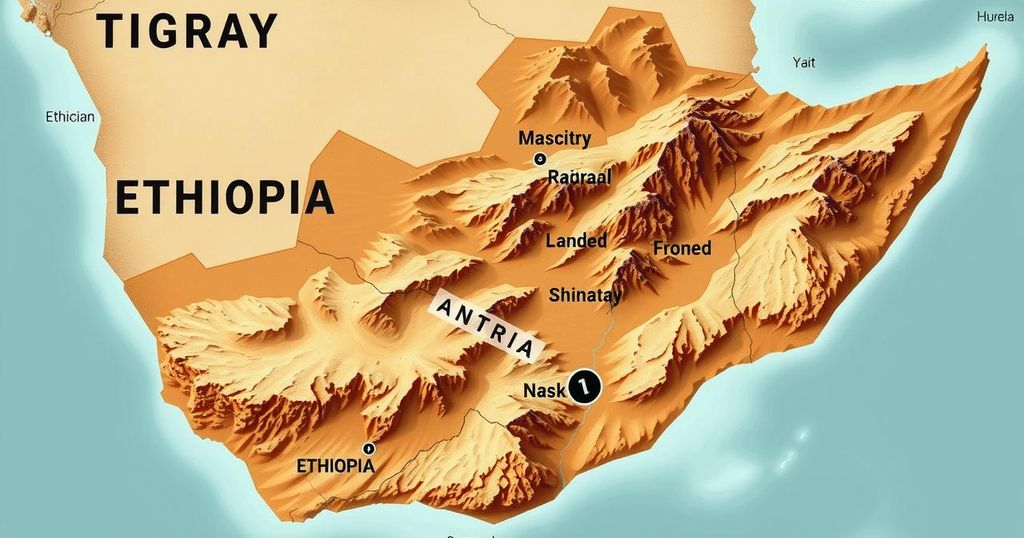Ethiopia’s Tigray Region Faces Renewed Conflict Amidst Political Turmoil

Ethiopia faces renewed conflict in Tigray two years after the Pretoria Agreement aimed at peace. Tensions among local leaders have raised fears of instability, with economic difficulties exacerbating the situation. Regional dynamics and foreign interests, especially from Middle Eastern nations, complicate potential resolutions and heighten uncertainty in the area.
The peace accords signed over two years ago between Ethiopia’s government and rival factions, known as the Pretoria Agreement, have now led to renewed tensions in the Tigray region. While the agreement initially ended significant conflict, fears of a new war are rising, with residents expressing growing concern over daily life and increased living costs. “People are not working, and long lines have formed at banks as they try to withdraw money,” stated resident Kiflom Abraha.
Despite a brief period of calm following the November 2022 peace agreement, many individuals remain displaced, and anxiety about a potential return to conflict persists. “After the Pretoria Agreement, there was peace, but with many challenges,” remarked Nigisti Garede, head of the Tigray Teachers’ Association. Disputes among Tigrayan leaders have led to further societal unrest and instability.
A significant rift among Tigrayan leaders has emerged, resulting in the sidelining of Getachew Reda, head of the Tigray Interim Regional Administration. Military support has shifted towards Debretsion Gebremichael, leader of the Tigray People’s Liberation Front (TPLF), exacerbating tensions. As Martin Plaut, a London-based analyst, observed, “The TPLF had been very united for many, many years. Now they are completely and utterly split.”
Prime Minister Abiy Ahmed, who has been in power since 2018, initially promoted reforms but faced backlash from Tigrayan elites. The ongoing conflict aimed to diminish the TPLF’s power but did not achieve its goals, leaving both sides frustrated. “This was something that was agreed on by both Prime Minister Abiy and the Eritrean leader, President Isaias Afwerki,” Plaut remarked, stating that their inability to militarily eradicate the TPLF has made the situation unresolved.
Political figures inside Ethiopia predict an imminent escalation of conflict, with Lt. Gen. Tsadkan Gebretensae asserting that a war “seems inevitable.” As both Ethiopia and Eritrea prepare for potential conflict, caution remains advised regarding predictions. Plaut remarked on Eritrea’s President Isaias, noting that he is typically decisive at pivotal moments.
The renewed strife emerges amidst ongoing crises in the Horn of Africa and the Red Sea. Tensions in the region are further complicated by conflicts in Sudan and maritime deals proposed by Ethiopia with Somaliland, which did not come to fruition. Moreover, Ethiopia’s ambitious hydropower initiatives have led to disputes with Egypt and Sudan.
The geopolitical landscape is influenced by the ambitions of Middle Eastern nations, with Saudi Arabia and the United Arab Emirates playing critical roles in the region’s stability. “You have to look at the foreign policy agenda of both the Saudis and the United Arab Emirates,” Plaut stated. The shifting alliances and aspirations in the region render the situation complex and uncertain.
The political landscape in Ethiopia remains precarious, as tensions in Tigray threaten renewed conflict despite previous peace accords. The power struggle among Tigrayan leaders adds to societal unrest and uncertainty. Observers caution against making predictions as regional dynamics evolve, particularly with the involvement of Middle Eastern interests, which further complicate stability in the Horn of Africa.
Original Source: www.dw.com







